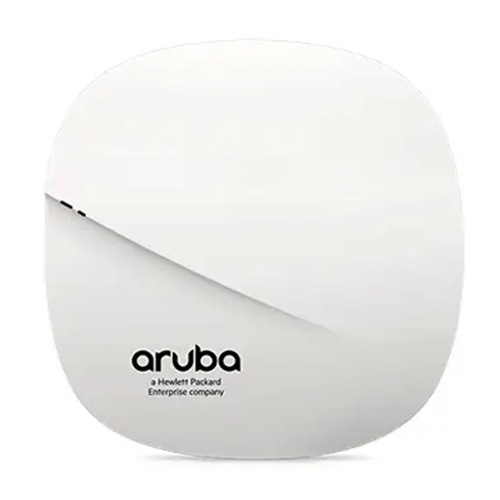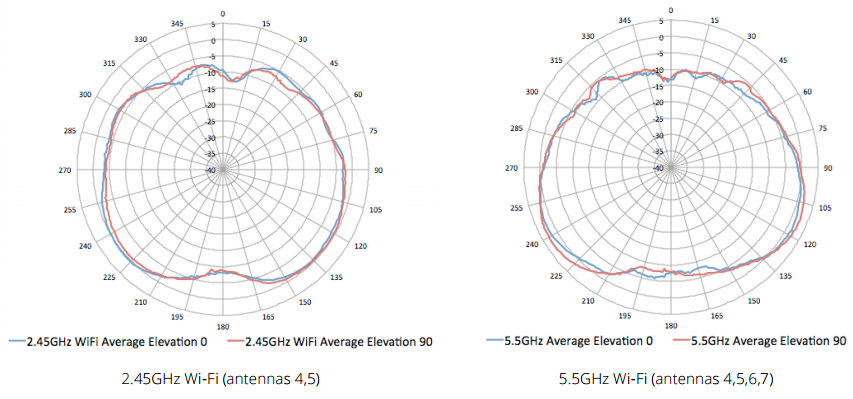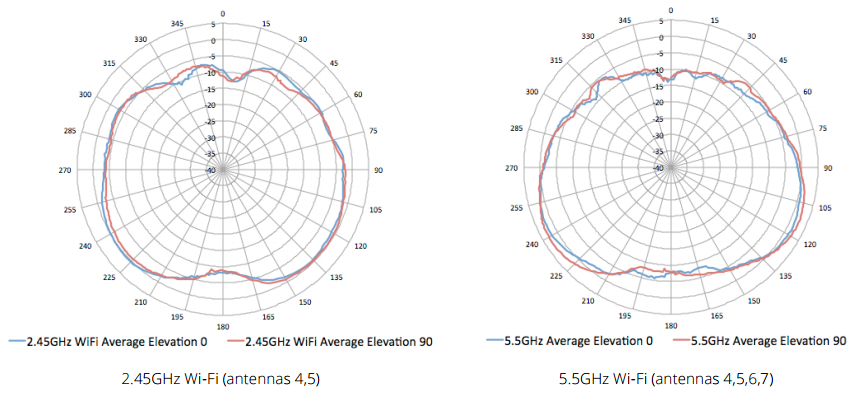
Aruba Access Point 315
Aruba Access Point 315 delivers high performance and an outstanding user experience for mobile devices, Internet of Things (IoT) devices, and applications in congested office environments. Featuring 4×4: 4SS MU-MIMO capability, advanced Aruba ClientMatch radio management, and Aruba Beacon technology, the 310 Series enables a cost-effective, all-wireless digital work environment.
Request a Quote
DESCRIPTION
Aruba Access Point 315 delivers high performance and an outstanding user experience for mobile devices, Internet of Things (IoT) devices, and applications in congested office environments. Featuring 4×4: 4SS MU-MIMO capability, advanced Aruba ClientMatch radio management, and Aruba Beacon technology, the 310 Series enables a cost-effective, all-wireless digital work environment.
With a maximum concurrent data rate of 1,733 Mbps in the 5 GHz band and 400 Mbps in the 2.4 GHz band (for aggregate peak data rates of 2.1 Gbps), 310 Series Access Points can quickly add the required capacity to your existing or new wireless. network. The mid-range 310 Series, with a single gigabit Ethernet uplink, are ideal for environments with high device densities, such as schools, retail branches, hotels and corporate offices, where organizations are cost sensitive.
The high-performance, high-density 802.11ac 310 series supports a channel bandwidth of 160 MHz (VHT160), multi-user MIMO (MU-MIMO), and 4 spatial streams (4SS). It provides simultaneous data transmission to multiple devices, maximizes data throughput and improves network efficiency.
The 310 Series includes enhanced ClientMatch technology that extends client steering technology to MU-MIMO client awareness. Automatically identifies MU-MIMO-enabled mobile devices and directs them to the nearest MU-MIMO-enabled Aruba access point. By grouping mobile devices that support MU-MIMO, the network is starting to take advantage of simultaneous transmissions to these devices, increasing their overall capacity. The dynamic roaming policy, which is based on this device type, helps users achieve the best WLAN performance in mixed device environments during technology transitions.
The 310 Series also has an integrated Bluetooth Aruba Beacon which simplifies remote management of a large-scale Aruba battery-powered beacon network while providing advanced location and indoor streetfinding, as well as proximity-based push notification capabilities. This enables businesses to take advantage of the mobility context to develop applications that will provide an enhanced user experience and increase the value of wireless networks for organizations.
Increase network efficiency
With multi-user MIMO (MU-MIMO), you can send to multiple Wave 2 clients from the AP, at the same time.
ClientMatch releases MU-MIMO
Aruba ClientMatch software batches Wave 2 clients, enabling MU-MIMO. That means a faster and more efficient network.
Integrated Bluetooth Beacon
The 310 AP Series has an integrated BLE Beacon to simplify the management of a large scale network of battery-powered Aruba Beacons.
Choose your mode of operation
The Aruba 310 Series Access Points offer a choice of operating modes to meet your unique management and deployment needs.
- Controller-managed mode – When managed by the Aruba Mobility Controller, the Aruba 310 Series Access Points offer centralized configuration, data encryption, policy enforcement, and network services, as well as centralized, distributed traffic forwarding.
- Aruba Instant mode – In Aruba Instant mode, one AP automatically distributes network configuration to other Instant APs on the WLAN. Just power on one Instant AP, configure over the air, and plug in another AP – the whole process takes about five minutes. If WLAN requirements change, the internal migration path allows the 310 Series instant AP to become part of the WLAN managed by the Mobility Controller.
- Remote AP (RAP) for branch deployment
- Air monitor (AM) for wireless IDS, rogue detection and containment
- Spectrum analyzers, dedicated or hybrid, to identify sources of RF interference
- Secure corporate nets
For large installations at multiple sites, the Aruba Activate service significantly reduces deployment time by automating device provisioning, firmware upgrades, and inventory management. With Aruba Activate, Instant APs are sent from the factory to any site and configured themselves at startup.
Dual Radio 802.11ac access point with Multi-User MIMO
- Supports up to 1.733Mbps in the 5GHz band (with 4SS / VHT80 or 2SS / VHT160 clients) and up to 400Mbps in the 2.4 GHz band (with 2SS / VHT40 clients).
Built-in Bluetooth Low-Energy (BLE) radio
- Enables location-based services with BLE-enabled mobile devices that receive signals from multiple Aruba Beacons simultaneously.
Advanced Cellular Coexistence (ACC)
- Minimizes interference from 3G / 4G cellular networks, distributed antenna systems and commercial small cell / femtocell equipment.
Quality of Service for Unified Communications Applications
- Support priority handling and policy enforcement for unified communications applications, including Microsoft Skype for Business with encrypted video conferencing, voice, chat, and desktop sharing.
RF Management
- Adaptive Radio Management (ARM) technology automatically assigns channel and power settings, provides fair broadcast time and ensures that the AP is kept clear of all sources of RF interference for a reliable, high-performance WLAN.
- The Aruba 310 Series AP can be configured to provide part-time or dedicated air monitoring for spectrum analysis and wireless intrusion protection, VPN tunnels for extending remote locations to corporate resources, and wireless mesh connections where Ethernet droplets are not available.
Support for additional 5GHz band
- Supports software upgrades to enable additional 5GHz spectrum as government expands available frequencies.
Intelligent application visibility and control
- AppRF technology takes advantage of deep packet inspection to classify and block, prioritize, or limit bandwidth for more than 1,500 enterprise applications or application groups.
Security
- Integrated wireless intrusion protection offers protection and threat mitigation, and eliminates the need for separate RF sensors and security equipment.
- IP reputation and security services identify, classify, and block malicious files, URLs and IPs, providing comprehensive protection against advanced online threats.
- Integrated Trusted Platform Module (TPM) for secure storage of credentials and keys.
Intelligent Power Monitoring (IPM)
- Allows the AP to continuously monitor and report on its actual power consumption and optionally make autonomous decisions to disable certain capabilities.
- For 310 Series access points, the IPM power saving feature takes effect when the unit is powered by an 802.3af PoE source. By default, the USB interface will be the first feature to turn off if the AP’s power consumption exceeds the available power budget. In rare cases it may be necessary to take additional power saving measures, but in most cases the 310 Series AP will operate in unlimited mode.
AP-314 and AP-315 Spesifikasi:
- AP-314 (controller-managed) and IAP-314 (Instant):
- 802.11ac – 5GHz 4×4 MIMO (1,733Mbps max rate) and 2.4GHz 2×2 MIMO (400Mbps max rate) radios, with a total of four dual-band RP-SMA connectors for external antennas
- AP-315 (controller-managed) and IAP-315 (Instant):
- 802.11ac – 5GHz 4×4 MIMO (1,733Mbps max rate) and 2.4GHz 2×2 MIMO (400Mbps max rate) radios, with a total of four integrated omni-directional downtilt dual-band antennas
Wireless Radio Spesifikasi
- AP type: Indoor, dual radio, 5GHz 802.11ac 4×4 MIMO and 2.4GHz 802.11n 2×2 MIMO
- Software-configurable dual radio supports 5GHz (Radio 0) and 2.4GHz (Radio 1)
- 5GHz: Four spatial stream Single User (SU) MIMO for up to 1,733Mbps wireless data rate to individual 4×4 VHT80 or 2×2 VHT160 client devices
- 2.4GHz: Two spatial stream Single User (SU) MIMO for up to 400 Mbps wireless data rate to individual 2×2 VHT40 client devices (300Mbps for HT40 802.11n client devices)
- 5GHz: Four spatial stream Multi User (MU) MIMO for up to 1,733 Mbps wireless data rate to up to three MU-MIMO capable client devices simultaneously
- Support for up to 255 associated client devices per radio, and up to 16 BSSIDs per radio
- Supported frequency bands (country-specific restrictions apply):
- 2.400 to 2.4835GHz
- 5.150 to 5.250GHz
- 5.250 to 5.350GHz
- 5.470 to 5.725GHz
- 5.725 to 5.850GHz
- Available channels: Dependent on configured regulatory domain
- Dynamic frequency selection (DFS) optimizes the use of available RF spectrum
- Supported radio technologies:
- 802.11b: Direct-sequence spread-spectrum (DSSS)
- 802.11a/g/n/ac: Orthogonal frequency-division multiplexing (OFDM)
- Supported modulation types:
- 802.11b: BPSK, QPSK, CCK
- 802.11a/g/n/ac: BPSK, QPSK, 16-QAM, 64-QAM, 256-QAM
- Transmit power: Configurable in increments of 0.5 dBm
- Maximum (conducted) transmit power (limited by local regulatory requirements):
- 2.4GHz band: +18 dBm per chain, +21dBm aggregate (2×2)
- 5GHz band: +18 dBm per chain, +24dBm aggregate (4×4)
- Note: conducted transmit power levels exclude antenna gain. For total (EIRP) transmit power, add antenna gain
- Advanced Cellular Coexistence (ACC) minimizes interference from cellular networks
- Maximum ratio combining (MRC) for improved receiver performance
- Cyclic delay/shift diversity (CDD/CSD) for improved downlink RF performance
- Short guard interval for 20MHz, 40MHz, 80MHz and 160MHz channels
- Space-time block coding (STBC) for increased range and improved reception
- Low-density parity check (LDPC) for high-efficiency error correction and increased throughput
- Transmit beam-forming (TxBF) for increased signal reliability and range
- Supported data rates (Mbps):
- 802.11b: 1, 2, 5.5, 11
- 802.11a/g: 6, 9, 12, 18, 24, 36, 48, 54
- 802.11n (2.4GHz): 6.5 to 300 (MCS0 to MCS15)
- 802.11n (5GHz): 6.5 to 600 (MCS0 to MCS31)
- 802.11ac: 6.5 to 1,733 (MCS0 to MCS9, NSS = 1 to 4 for VHT20/40/80, NSS = 1 to 2 for VHT160)
- 802.11n high-throughput (HT) support: HT 20/40
- 802.11ac very high throughput (VHT) support: VHT 20/40/80/160
- 802.11n/ac packet aggregation: A-MPDU, A-MSDU
Antena WiFi
- AP-314 / IAP-314: Empat konektor RP-SMA untuk antena dual band eksternal. Kehilangan internal kasus terburuk antara antarmuka radio dan konektor antena eksternal (karena sirkuit diplexing): 0.6dB di 2.4GHz dan 1.2dB di 5GHz.
- AP-315 / IAP-315: Empat antena omni-directional downtilt dual-band terintegrasi untuk 4×4 MIMO dengan penguatan antena maksimum 3,1dBi pada 2,4GHz dan 5,0dBi pada 5GHz. Antena internal dioptimalkan untuk orientasi Titik Akses yang dipasang di langit-langit horizontal. Sudut kemiringan untuk penguatan maksimum kira-kira 30 derajat.
- Gain maksimum dari pola antena gabungan (dijumlahkan) untuk semua elemen yang beroperasi pada pita yang sama adalah 3,9dBi pada 2,4GHz dan 5,7dBi pada 5GHz.
Antarmuka Lainnya
- One 10/100/1000BASE-T Ethernet network interface (RJ-45)
- Auto-sensing link speed and MDI/MDX
- 802.3az Energy Efficient Ethernet (EEE)
- USB 2.0 host interface (Type A connector)
- Bluetooth Low Energy (BLE) radio
- Up to 4dBm transmit power (class 2) and -91dBm receive sensitivity
- Integrated antenna with roughly 30 degrees downtilt and peak gain of 3.4dBi (AP-314/IAP-314) or 1.5dBi (AP-315/IAP-315)
- Indikator visual (LED multi-warna): untuk status Sistem dan Radio
- Reset button: reset pabrik (selama perangkat menyala)
- Antarmuka konsol serial (berpemilik; kabel adaptor opsional tersedia)
- Slot keamanan Kensington
Sumber Daya dan Konsumsi
- AP mendukung daya DC langsung dan Power over Ethernet (POE)
- Jika kedua sumber daya tersedia, daya DC lebih diprioritaskan daripada POE
- Sumber listrik dijual terpisah
- Sumber DC langsung: nominal 12Vdc, +/- 5%
- Antarmuka menerima konektor melingkar positif tengah 2,1 / 5,5 mm dengan panjang 9,5 mm
- Power over Ethernet (POE): 48 Vdc (nominal) sumber yang sesuai dengan 802.3af / 802.3at
- Fungsionalitas tidak terbatas dengan 802.3at POE
- Saat menggunakan IPM, AP dapat memasuki mode hemat daya dengan fungsionalitas yang berkurang saat didukung oleh sumber POE 802.3af (lihat detail tentang Intelligent Power Monitoring di tempat lain di lembar data ini)
- Tanpa IPM, port USB dinonaktifkan dan daya pancar dari radio chain 2.4GHz dikurangi sebesar 3dB hingga 15dBm maks saat AP diaktifkan oleh dan sumber POE 802.3af
- Maximum (worst-case) power consumption: 14.4W (802.3at POE), 13.6W (802.3af POE) or 12.7W (DC)
- Tidak termasuk daya yang dikonsumsi oleh perangkat USB eksternal (dan overhead internal); ini bisa bertambah hingga 6,3W (POE) atau 5,9W (DC) untuk perangkat USB 5W / 1A
- Konsumsi daya maksimum (kasus terburuk) dalam mode siaga: 6,4W (POE) atau 5,9W (DC)
Pemasangan
- AP dikirimkan dengan dua klip pemasangan (putih) untuk dipasang ke langit-langit drop-tile datar berukuran 9/16 inci atau 15/16 inci.
- Beberapa kit pemasangan opsional tersedia untuk memasang Titik Akses ke berbagai permukaan; lihat bagian Informasi Pemesanan di bawah untuk detailnya
Mekanis
- Dimensi / berat (unit, tidak termasuk aksesoris dudukan):
- 182mm(W) x 180mm(D) x 48mm (H)
- 650g/23oz
- Dimensi / berat (pengiriman):
- 223mm(W) x 218mm(D) x 55mm(H) (W x D x H)
- 850g/30oz
Lingkungan
- Pengoperasian:
- Temperature: 0° C to +50° C (+32° F to +122° F)
- Humidity: 5% to 95% non-condensing
- Penyimpanan dan transportasi:
- Temperature: -40° C to +70° C (-40° F to +158° F)
Peraturan
- FCC/Industry of Canada
- CE Marked
- R&TTE Directive 1995/5/EC
- Low Voltage Directive 72/23/EEC
- EN 300 328
- EN 301 489
- EN 301 893
- UL/IEC/EN 60950
- EN 60601-1-1 and EN 60601-1-2
Untuk informasi lebih lanjut tentang peraturan negara tertentu dan persetujuan, silakan lihat perwakilan Aruba Anda.
Keandalan
- MTBF: 916,373hrs (105yrs) at +25C operating temperature
Nomor Model Pengaturan
- AP-314 and IAP-314: APIN0314
- AP-315 and IAP-315: APIN0315
Sertifikasi
- CB Scheme Safety, cTUVus
- UL2043 plenum rating
- Wi-Fi Alliance (WFA) certified 802.11a/b/g/n/ac
Jaminan
- Garansi seumur hidup terbatas Aruba
Versi software Minimum
- ArubaOS 6.5.0.0
- Aruba InstantOS 4.3.0.0
| RF Performance Table | ||
|---|---|---|
| Maximum transmit power (dBm) per transmit chain | Receiver sensitivity (dBm) per receive chain | |
| 2.4 GHz – 802.11b | ||
| 1 Mbps | 18.0 | -95.0 |
| 11 Mbps | 18.0 | -88.0 |
| 2.4 GHz – 802.11g | ||
| 6 Mbps | 18.0 | -91.0 |
| 54 Mbps | 16.0 | -74.0 |
| 2.4 GHz – 802.11n HT20 | ||
| MCS0/8 | 18.0 | -90.0 |
| MCS7/15 | 14.0 | -71.0 |
| 2.4 GHz – 802.11n HT40 | ||
| MCS0/8 | 18.0 | -87.0 |
| MCS7/15 | 14.0 | -68.0 |
| 5 GHz – 802.11a | ||
| 6 Mbps | 18.0 | -90.0 |
| 54 Mbps | 16.0 | -73.0 |
| 5 GHz – 802.11n HT20 | ||
| MCS0/8 | 18.0 | -90.0 |
| MCS7/15 | 14.0 | -71.0 |
| 5 GHz – 802.11n HT40 | ||
| MCS0/8 | 18.0 | -87.0 |
| MCS7/15 | 14.0 | -68.0 |
| 5 GHz – 802.11ac VHT20 | ||
| MCS0 | 18.0 | -90.0 |
| MCS9 | 12.0 | -65.0 |
| 5 GHz – 802.11ac VHT40 | ||
| MCS0 | 18.0 | -87.0 |
| MCS9 | 12.0 | -62.0 |
| 5 GHz – 802.11ac VHT80 | ||
| MCS0 | 18.0 | -83.0 |
| MCS9 | 12.0 | -59.0 |
| 5 GHz – 802.11ac VHT160 | ||
| MCS0 | 18.0 | -82.0 |
| MCS9 | 12.0 | -57.0 |
Displays azimuth pattern (0 degrees) and 30 degrees downward
Elevation planes (side view, AP facing down)
Displays a side view with AP rotated 0 and 90 degrees



